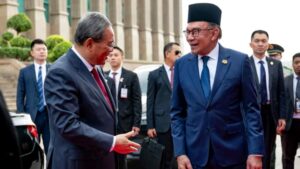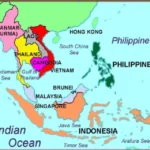Comparing BRICS and ASEAN, some member nations belong to both – but for what purpose?
Image: FactCheckTV
As it currently stands, BRICS emphasises emerging economies’ collaboration, while ASEAN focuses on regional cooperation among Southeast Asian nations. Both groups play essential roles in shaping global economic and political landscapes. But with the rise of BRICS and China accounting for 85% of total intra-BRICS trade and their US$10 bil commitment to the New Development Bank (NDB)- should ASEAN be concerned?
BRICS (Brazil, Russia, India, China, South Africa) is motivated to reduce the dependence on/ and the dominance of Western economic markets and specifically on U.S. dollars in settlements – by enhanced economic growth through joint projects and investments and increased geopolitical influence on global decision-making to diversify trade partners. Saudi Arabia, Iran, Ethiopia, Egypt, Argentina and the United Arab Emirates are seeking to join – and more than 40 countries have expressed interest.
Thailand has already applied and awaiting approval to become a BRICS member, Thai Government spokesman Chai Wacharonke said Thailand recognised the importance of multilateralism and the increasing role of developing countries, Bangkok Post reported.
Meanwhile, among Southeast Asian nations, Indonesia, Thailand, Myanmar, Laos, Cambodia have previously expressed interest in joining the trade alliance, while Vietnam had said they were “closely monitoring the process of BRICS membership expansion”.
BRICS is projected to account for 45 per cent of global gross domestic product in purchasing power parity terms by 2030 and has evolved into a political formation.
ASEAN (Association of Southeast Asian Nations) with Brunei, Cambodia, Indonesia, Laos, Malaysia, Myanmar, the Philippines, Singapore, Thailand, and Vietnam is a regional intergovernmental organization comprising ten Southeast Asian countries focusing on economic cooperation, political stability, and cultural exchange.
Meanwhile, Southeast Asian nations of Indonesia, Thailand, Myanmar, Laos, and Cambodia have previously expressed interest in joining the trade alliance, while Vietnam have said they are “closely monitoring the process of BRICS membership expansion”.
There are concerns that more ASEAN states expressing interest in joining BRICS could lead to overdependence on China.
While ASEAN nations have deepening economic ties with China, including multinational corporations relocating production bases to countries like Vietnam, Thailand, and Indonesia – ASEAN also provides a counterbalance to Russia’s power and economy, especially given Russia’s economic challenges due to the war in Ukraine and sanctions.
China’s influence extends across both BRICS and ASEAN. China’s contributions include pledging US$10 billion to the New Development Bank (NDB), which aims to provide development financing, and participating in a $100 billion contingency fund for balance-of-payments pressures. Bilateral trade between China and other BRICS nations accounts for 85% of total intra-BRICS trade. China’s cheap manufactured goods also impact its partners– but as Vietnam excels in manufacturing g sector, this could tip the scales.
Today, BRICS+ nations account for half the world’s population and two-fifths of trade, including top energy producers and importers. BRICS+ nations also account for 38% of global petroleum imports, led by China and India.

JUNE 2024- Malaysian Prime Minister Anwar Ibrahim, right, welcomes Chinese Premier Li Qiang for a bilateral meeting in Putrajaya, Malaysia.
(Photo courtesy of Prime Minister’s Office of Malaysia)
Ahead of China Premier Li Qiang arrival in Malaysia last week for the celebrations to mark the 50th year of diplomatic relations between Malaysia and China – Malaysia Prime Minister Anwar Ibrahim announced they are preparing to join the BRICS group of emerging economies.
28 June, 2024: Southeast Asia’s sudden pivot toward the BRICS nations is a global game-changer that few in Washington saw coming. (AsiaTimes)
“A gradual democratization of the global financial landscape may be underway, giving way to a world in which more local currencies can be used for international transactions,” says analyst Hung Tran at the Atlantic Council’s Geoeconomics Center. “In such a world, the dollar would remain prominent but without its outsized clout, complemented by currencies such as the Chinese renminbi, the euro and the Japanese yen in a way that’s commensurate with the international footprint of their economies.”
Tran notes that “in this context, how Saudi Arabia approaches the petrodollar remains an important harbinger of the financial future.”
Soumya Bhowmick, an associate fellow at the Observer Research Foundation think tank, says Thailand’s bid supports Beijing’s broader strategic goals of expanding Chinese economic influence in Southeast Asia.
What is the deep underlining economic strategy and perceived benefits of BRICS? BRICS has the ability within their collective voice to impact trade policies, WTO negotiations, and regional trade blocs.
While there is not a specific BRICS cryptocurrency yet, the group is actively exploring digital payment solutions, they are working on creating a payment system based on blockchain and digital technologies. The goal is to make it convenient, cost-effective, and free from political influence.
Currency Swap Agreements: BRICS nations have established currency swap arrangements to facilitate trade in local currencies, reducing reliance on the US dollar.
Development Banks: The New Development Bank (NDB), founded by BRICS, finances infrastructure projects in member countries.
Geopolitical Influence: BRICS challenges the dominance of Western economies by providing an alternative voice in global affairs. It advocates for multipolarity, emphasizing the importance of emerging economies in shaping international policies.
Resource Sharing and Technology Transfer: BRICS members share knowledge, expertise, and technology across sectors like energy, agriculture, and healthcare. Joint research initiatives promote sustainable development and innovation.
Energy Security and Climate Change: BRICS collaborates on energy security, renewable energy, and climate change mitigation. They work together to address environmental challenges and promote sustainable practices.
South-South Cooperation: BRICS fosters cooperation among developing nations, promoting economic growth and poverty reduction. It aims to create a south-south cooperative framework, strengthening ties beyond traditional North-South relations.
Perceived Benefits: Enhanced economic growth through joint projects and investments Increased geopolitical influence on global decision-making. Diversification of trade partners and reduced dependence on Western markets. Shared best practices and technological advancements.
ASIA TIMES 28 June, 2024 artical Southeast Asia has its reasons for pivoting to BRICS HERE+















